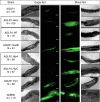Blood meal-induced inhibition of vector-borne disease by transgenic microbiota
- PMID: 30297781
- PMCID: PMC6175951
- DOI: 10.1038/s41467-018-06580-9
Blood meal-induced inhibition of vector-borne disease by transgenic microbiota
Abstract
Vector-borne diseases are a substantial portion of the global disease burden; one of the deadliest of these is malaria. Vector control strategies have been hindered by mosquito and pathogen resistances, and population alteration approaches using transgenic mosquitos still have many hurdles to overcome before they can be implemented in the field. Here we report a paratransgenic control strategy in which the microbiota of Anopheles stephensi was engineered to produce an antiplasmodial effector causing the mosquito to become refractory to Plasmodium berghei. The midgut symbiont Asaia was used to conditionally express the antiplasmodial protein scorpine only when a blood meal was present. These blood meal inducible Asaia strains significantly inhibit pathogen infection, and display improved fitness compared to strains that constitutively express the antiplasmodial effector. This strategy may allow the antiplasmodial bacterial strains to survive and be transmitted through mosquito populations, creating an easily implemented and enduring vector control strategy.
Conflict of interest statement
The authors declare no competing interests.
Figures






References
-
- WHO. Vector-borne diseases. Available at: http://www.who.int/en/news-room/fact-sheets/detail/vector-borne-diseases. (2017).
-
- Institute of Medicine. Vector-Borne Diseases: Understanding the Environmental, Human Health, and Ecological Connections: Workshop Summary. Washington, DC: The National Academies Press; 2008. - PubMed
-
- Roberts DR, Andre A. Insecticide resistance issues in vector-borne disease control. Trop. Med. 1994;50:21–34. - PubMed
Publication types
MeSH terms
Grants and funding
LinkOut - more resources
Full Text Sources
Other Literature Sources
Medical
Research Materials

